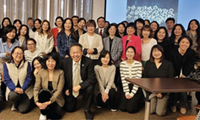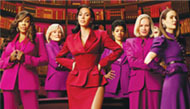It is not unlike the world he has conjured for his current project: an exhibition of portraits of the Haitian community in Miami at the Museum of Contemporary Art in North Miami, his first major show in an American museum.
Many of the images first appeared in 2003, in the aftermath of the boat disaster that left hundreds of refugees stranded and held in Miami detention centers. Like his later photographs of Haitians being treated in Miami after the earthquake that destroyed much of Port-au-Prince in January, and in the light of the cholera epidemic devastating the island, they carry an urgent emotional weight.
More than that, they cast Mr. Weber, 64, a professional chronicler of beauty, in the unaccustomed role of activist.
In a way, he said, the label fits. Chatting on his beachfront patio , he said: “Ansel Adams was an activist. He drew your attention to all the great national parks. If you’re any kind of photographer, you are an activist.”
Bearded, burly, his pate swathed in the trademark bandanna he wears even while swimming, an ancient Rolleiflex slung from his neck, he is every inch a self-styled outsider, documenting his world from a position of safety behind the lens.
“As a photographer, you’re always making a fool of yourself,” he said, “telling subjects, ‘Oh, I think you’re so wonderful, can I take your picture?’ That’s a vulnerable thing.”
Discernible in each of his 75 portraits in the Miami show is a wellspring of empathy, the pictures tugging at viewers’ feelings in ways unanticipated by Mr. Weber’s critics. Some have said that in his earlier work, he accentuated his subjects’ beefcake qualities in ways that bring to mind Fascist-era imagery.
Mr. Weber, who has been influenced by American Scene painters like Thomas Hart Benton, bristled. “Just because you sit on the ground and point your camera upward does not mean you want to emulate Leni Riefenstahl,” he said.
Bonnie Clearwater, the director and chief curator of the Miami museum, allowed that Mr. Weber’s subjects can at first seem unapproachable. His pictures “have the effect of a sculpture,” she said. “But because you feel you can caress the subject - man, woman or child - the experience of seeing becomes almost tactile. And because you feel you can touch these people, you care about them.”
Until now Americans have seen these people only as “wet, frightened and fighting for their lives,” Mr. Weber said. But he trained his lens on another side of the Haitian community, his view shaped by years of shooting fashion advertising for Ralph Lauren, Calvin Klein and Abercrombie & Fitch, and stylish editorials for Vogue and Vanity Fair.
“If I hadn’t had the background of taking fashion pictures,” he said, “I wouldn’t have been able to make pictures of these people. I wouldn’t have captured their elegance.”
It took doggedness to record those images, but, then, as he acknowledged, he can be hardheaded.
But the shell he has cultivated can be a cover for the anxieties that plague him - or drive him - each time he makes a picture.
“As a kid,” he said, “I was just as nervous as anybody. I still am.”
By RUTH LA FERLA
스마터리빙
more [ 건강]
[ 건강]이제 혈관 건강도 챙기자!
[현대해운]우리 눈에 보이지 않기 때문에 혈관 건강을 챙기는 것은 결코 쉽지 않은데요. 여러분은 혈관 건강을 유지하기 위해 어떤 노력을 하시나요?
 [ 건강]
[ 건강]내 몸이 건강해지는 과일궁합
 [ 라이프]
[ 라이프]벌레야 물럿거라! 천연 해충제 만들기
 [ 건강]
[ 건강]혈압 낮추는데 좋은 식품
[현대해운]혈관 건강은 주로 노화가 진행되면서 지켜야 할 문제라고 인식되어 왔습니다. 최근 생활 패턴과 식생활의 변화로 혈관의 노화 진행이 빨라지고
사람·사람들
more많이 본 기사
- 널뛰는 환율에, 뒤돌아서니 1000만 원 손해
- 현대차·기아, 11월 돌려받는 관세만 ‘1400억’
- 韓 ‘집값 빈부격차’ 커져 상하위 10%, 45배 차
- ‘한국 핵잠·우라늄 농축’ 팩트시트 못박았다
- ‘이효리♥’ 이상순, 60억 평창동 家 거실의 가을..행복이 가득
- 몸값 4천400% 뛴 이트륨…中 희토류 통제로 항공·반도체 비상
- 3500억불 투자 MOU 서명… “조선 협력 수익은 전액 한국에”
- 트럼프 “베네수엘라 겨냥 다음단계 조치 결심…내용은 말못해”
- 트럼프, 사우디 빈살만 ‘국제 왕따’… 1
- 애플, 워치 혈중산소 측정 특허소송 패소…6억3천400만 달러 배상 평결
- 캘리포니아서 ‘저소득층에 쓰자’ 억만… 1
- 나나, 자택에 침입한 강도 제압..소속사 측 “경찰 수사 중”
- [신앙 에세이] “할아버지와 안경”
- ‘사망설’ 前엑소 크리스 누구..강간 혐의로 복역·강제 거세 가능성 “징역 후 캐나다로 추방”
- 워싱턴 한인 2세 기업, 미국서‘일냈… 1
- 농축산물 개방 막았지만… 미국산 LMO(유전자변형생물체) 감자 도입 빨라진다
- “백악관 연일 안보라인 소집…베네수엘라 타격 여부 저울질”
- 타깃 이어 월마트도…유통공룡들 잇따라… 1
- 뉴욕시 아파트 도로변에 대형 밀폐 쓰… 1
- ‘직무유기’ 조태용, 구속적부심 청구… “증거인멸 우려 없어”
- ‘마두로 압박’ 美·트리니다드토바고 또 합동 군사훈련
- 워런 버핏의 버크셔, 구글 알파벳 주식 43억 달러대 매입
- “방시혁 잘못 있다면 벌받겠지..뉴진스랑 왜 섞어?” 1000곡 ‘저작권료 부자’ 윤일상, 또 소신 발언
- 트럼프, 커피·열대과일등 일부 농산물에 국가별관세 면제지시
- “오타니·야마모토 WBC 불참했으면” 로버츠 솔직 고백→김혜성에도 영향 미치나
- 구글, 텍사스에 데이터센터 한꺼번에 … 1
- 뉴욕증시, AI 칩 감가상각 논란 확산…혼조 마감
- 美국방차관 “韓은 모범동맹…NATO외 ‘GDP 3.5% 국방비’ 첫국가”
- 김수현, 20억원 소송 시작됐다..재판부 “귀책 사유 특정해달라” 손배소 첫 변론기일서 요청
- 최장 셧다운 끝났지만… 후폭풍은 지속된다
- 美, 1급기밀로 알리바바 주시… “中정부와 군사적 연계”
- 강성훈, 친동생과 듀오 ‘강남매’ 결… 1
- ‘중국 쉬인 입점’ 파리 백화점서 유… 1
- 한인 향군단체들 베테런스데이 퍼레이드 참가
- 뉴욕주 ‘가스레인지 퇴출’ 일단 보류 1
- 여, 검란 맞서 ‘검사 파면 법안’ 발의
- 유해란, LPGA 투어 안니카 드리븐 2R 공동 3위…선두와 1타 차
- [삶과 생각] 첫 크루즈 여행과 부흥의 축복
- “김치와 K-문화가 어우러지는 축제”
- “NJ 차량보험료 책정 기준서 운전자 학력·직업 제외시켜라”
- 센터빌 중심가에 어덜트 데이케어 오픈
- ‘이 대통령 연수원 동기’ 박수근 교수, 중앙노동위원장에 내정
- ‘손흥민 원더골+조규성 감동 복귀포’ 홍명보호, 볼리비아 2-0 격파... 2연승 질주
- 법원, 퍼듀파마 ‘마약성 진통제 사태’ 70억 달러 규모 합의안 승인
- 스위스, 美관세 39→15% 낮추고 … 1
- ‘부동산’ ‘대장동’ 반사이익 못 본 국힘
- 평화구상 이행 삐걱대는 틈타…가자지구 장악력 키우는 하마스
- 구글 “’광고시장서 지배력 남용’ EU 결정에 불복…법적 대응”
- 사우디 등 무슬림 8개국 “美주도 가자 유엔결의안 지지”
- 국무副장관 “제조업부흥에 韓역할 핵심… 1
1/5지식톡

-
 테슬라 자동차 시트커버 장착
0
테슬라 자동차 시트커버 장착
0테슬라 시트커버, 사놓고 아직 못 씌우셨죠?장착이 생각보다 쉽지 않습니다.20년 경력 전문가에게 맡기세요 — 깔끔하고 딱 맞게 장착해드립니다!장착비용:앞좌석: $40뒷좌석: $60앞·뒷좌석 …
-
 식당용 부탄가스
0
식당용 부탄가스
0식당용 부탄가스 홀세일 합니다 로스앤젤레스 다운타운 픽업 가능 안녕 하세요?강아지 & 고양이 모든 애완동물 / 반려동물 식품 & 모든 애완동물/반려동물 관련 제품들 전문적으로 홀세일/취급하는 회사 입니다 100% …
-
 ACSL 국제 컴퓨터 과학 대회, …
0
ACSL 국제 컴퓨터 과학 대회, …
0웹사이트 : www.eduspot.co.kr 카카오톡 상담하기 : https://pf.kakao.com/_BEQWxb블로그 : https://blog.naver.com/eduspotmain안녕하세요, 에듀스팟입니다…
-
 바디프렌드 안마의자 창고 리퍼브 세…
0
바디프렌드 안마의자 창고 리퍼브 세…
0거의 새제품급 리퍼브 안마의자 대방출 한다고 합니다!8월 23일(토)…24일(일) 단 이틀!특가 판매가Famille: $500 ~ $1,000Falcon: $1,500 ~ $2,500픽업 & 배송직접 픽업 가능LA…
-
 바디프렌드 안마의자 창고 리퍼브 세…
0
바디프렌드 안마의자 창고 리퍼브 세…
0거의 새제품급 리퍼브 안마의자 대방출 한다고 합니다!8월 23일(토)…24일(일) 단 이틀!특가 판매가Famille: $500 ~ $1,000Falcon: $1,500 ~ $2,500픽업 & 배송직접 픽업 가능LA…
케이타운 1번가
오피니언

선천적 복수국적 모순 이제는 바로잡아야

상처만 남은 연방정부 셧다운 종료
 조지 F·윌 워싱턴포스트 칼럼니스트
조지 F·윌 워싱턴포스트 칼럼니스트 [조지 F. 윌 칼럼] 바이든과 트럼프, 이민 정책의 실패
 김미선 서북미문인협회 회장시인
김미선 서북미문인협회 회장시인 [한국춘추] 국적의 경계 너머, 문학의 시민권
 전병두 서북미수필가협회 회원
전병두 서북미수필가협회 회원 [금요단상] 배려하는 마음
 조영헌 / 고려대 역사교육학과 교수
조영헌 / 고려대 역사교육학과 교수 [역사속 하루] 장원급제의 비밀 붓, 저장성의 호필(湖筆)
 서정명 / 서울경제 논설위원
서정명 / 서울경제 논설위원[만화경] ‘예송논쟁’과 종묘 고층개발 논란
 한 영 재미수필가협회 회장
한 영 재미수필가협회 회장 [한영의 독서칼럼] 스토너
 정다은 서울경제 국제부 기자
정다은 서울경제 국제부 기자 [글로벌 왓] 푸젠함·스텔스드론까지… ‘군사굴기’ 속도내는 중국
1/3지사별 뉴스

역대최장 ‘셧다운’ 끝⋯43일만에 문 연 연방정부
▶ 보험료 급등 혼란 우려⋯ 내년 중간선거 앞두고 민심 향방 변수역대 최장기로 기록된 연방정부의 셧다운(일부 기능 정지)이 12일 밤 종료됐다…
이민자 생체정보 수집 시민권자도 포함 논란

CKA, 오늘 워싱턴서 연례 갈라
차세대 한인 리더 네트워크인 미주한인위원회(CKA, 대표 아브라함 김)가 14일(금) 워싱턴서 연례 갈라(Gala)를 개최한다.이번 행사는 백…
스미소니언 박물관, 오늘부터 일부 개방

이민자 생체정보 수집 시민권자도 포함 논란
연방 국토안보부(DHS)가 이민 절차 전반에 걸쳐 생체정보(biometric data) 수집을 대폭 확대하는 규정 초안을 연방관보에 게재했다.…
정부 언제 정상화?

오늘 하루 이 창 열지 않음 닫기 




















































.png)


댓글 안에 당신의 성숙함도 담아 주세요.
'오늘의 한마디'는 기사에 대하여 자신의 생각을 말하고 남의 생각을 들으며 서로 다양한 의견을 나누는 공간입니다. 그러나 간혹 불건전한 내용을 올리시는 분들이 계셔서 건전한 인터넷문화 정착을 위해 아래와 같은 운영원칙을 적용합니다.
자체 모니터링을 통해 아래에 해당하는 내용이 포함된 댓글이 발견되면 예고없이 삭제 조치를 하겠습니다.
불건전한 댓글을 올리거나, 이름에 비속어 및 상대방의 불쾌감을 주는 단어를 사용, 유명인 또는 특정 일반인을 사칭하는 경우 이용에 대한 차단 제재를 받을 수 있습니다. 차단될 경우, 일주일간 댓글을 달수 없게 됩니다.
명예훼손, 개인정보 유출, 욕설 등 법률에 위반되는 댓글은 관계 법령에 의거 민형사상 처벌을 받을 수 있으니 이용에 주의를 부탁드립니다.
Close
x